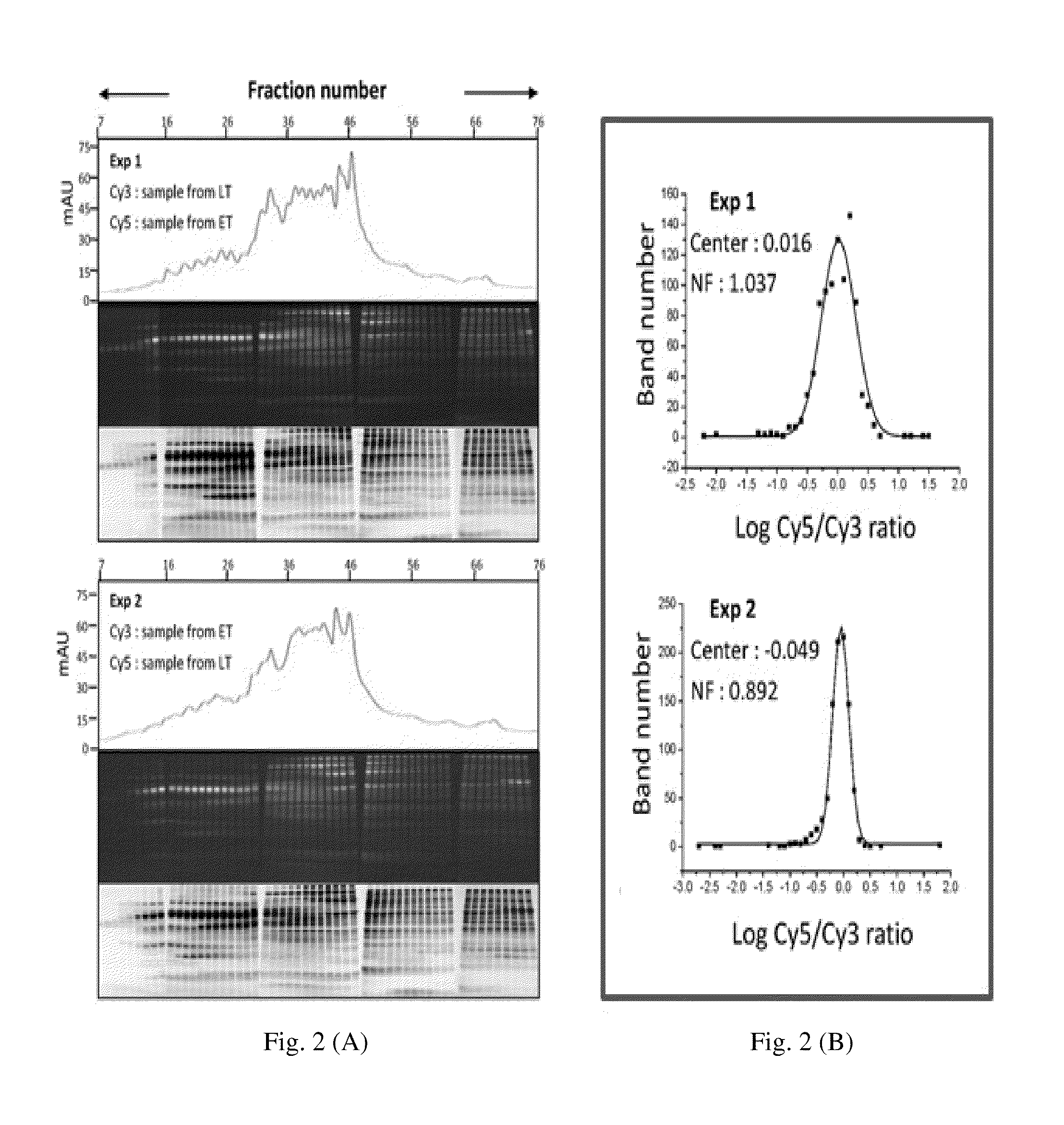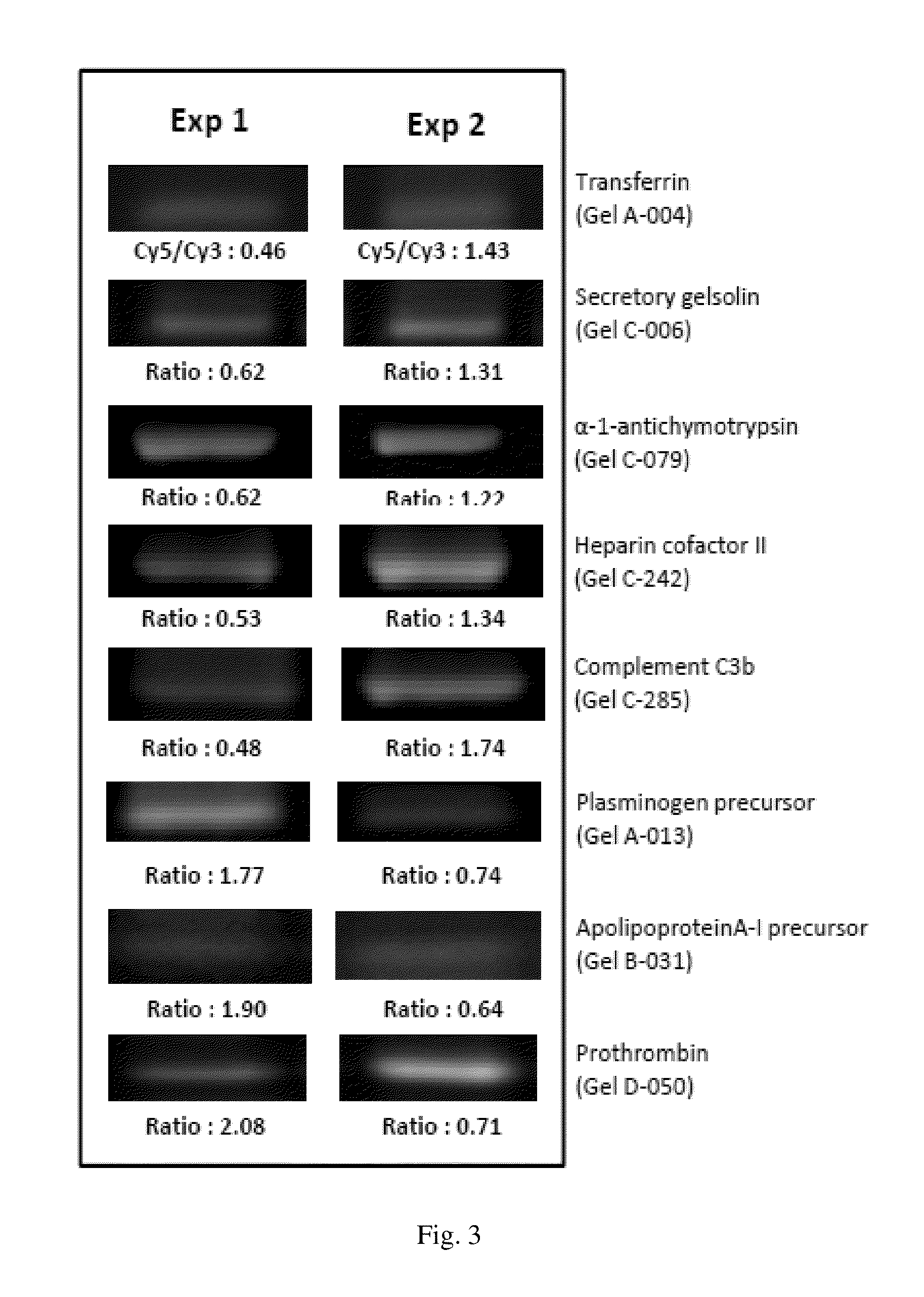Plasma biomarker for distal metastasis in colorectal cancer
a colorectal cancer and biomarker technology, applied in the field of colorectal cancer biomarkers for detecting distal crc metastasis, can solve the problems of insufficient sensitivity of cea in evaluating distal crc metastasis, inability to detect distal crc metastasis in blood, and inability to detect distal crc metastasis accurately. to achieve the effect of better detecting the distal crc metastasis
- Summary
- Abstract
- Description
- Claims
- Application Information
AI Technical Summary
Benefits of technology
Problems solved by technology
Method used
Image
Examples
embodiments
Embodiment I
Searching for CRC Metastasis-Associated Biomarkers in Blood
[0029]Some research reports point out the fact: Analyzing the intensity of fluorescent images with proteomics platform, the fluorescent labeling technology and the multi-dimensional fractionation system can successfully find out differentially-expressing proteins in the blood samples of the patients of nasopharyngeal cancer. These proteins are candidates for blood biomarkers of nasopharyngeal cancer (refer to Wu, C. C., et al. 2008, Proteomics 8: 3605-3620, and Peng, P. H. et al. 2011, J Proteomics 74: 744-757). The Inventors used a similar platform to search for promising CRC metastasis-associated biomarkers in the blood samples of the patients at different stages of CRC. In the embodiment, the Inventors used the proteomic technology to search for CRC metastasis-associated biomarkers in the blood samples of CRC patients, and the flowchart of the search strategy is shown in FIG. 1.
[0030]From 1995 to 2003, the Inv...
embodiment ii
Analysis of Fluorescent Images and Identification of Differentially-Expressing Proteins
[0035]In this embodiment, use image analysis software to quantitatively measure the fluorescence of each protein in the electrophoresis gels, and select the candidates of blood cancer biomarkers, whose fluorescence values vary in different groups. Using the preset fluorescence value as the screening condition, the Inventors found 15 proteins whose fluorescence increase after CRC metastasis and 15 proteins whose fluorescence decrease after CRC metastasis. Next, cut off the bands containing the 30 candidate proteins from the electrophoresis gels respectively. Next, perform enzymatic hydrolysis of the proteins in the gel bands with Trypsin, and use mass-spectrometers (MALDI-TOF MS and MicrOTOF-Q MS) to analyze the hydrolyzed candidate proteins.
[0036]Among the 30 gel bands, the Inventor found 5 proteins whose concentrations increase after distal metastasis, including serotransferrin, pGSN, alpha-1-ant...
embodiment iii
Using the Western Blot Method to Prove that pGSN Increases with the Distal Metastasis of CRC
[0037]The Inventors used the Western blot method to verify whether a protein molecule pGSN is associated with the distal metastasis of CRC. In the embodiment, the pGSN protein has the following amino acid sequence (SEQ ID NO:1):
1Met-Ala-Pro-His-Arg-Pro-Ala-Pro-Ala-Leu-Leu-Cys-Ala-Leu-Ser-Leu-Ala-Leu-Cys-Ala- 21Leu-Ser-Leu-Pro-Val-Arg-Ala-Ala-Thr-Ala-Ser-Arg-Gly-Ala-Ser-Gln-Ala-Gly-Ala-Pro- 41Gln-Gly-Arg-Val-Pro-Glu-Ala-Arg-Pro-Asn-Ser-Met-Val-Val-Glu-His-Pro-Glu-Phe-Leu- 61Lys-Ala-Gly-Lys-Glu-Pro-Gly-Leu-Gln-Ile-Trp-Arg-Val-Glu-Lys-Phe-Asp-Leu-Val-Pro- 81Val-Pro-Thr-Asn-Leu-Tyr-Gly-Asp-Phe-Phe-Thr-Gly-Asp-Ala-Tyr-Val-Ile-Leu-Lys-Thr-101Val-Gln-Leu-Arg-Asn-Gly-Asn-Leu-Gln-Tyr-Asp-Leu-His-Tyr-Trp-Leu-Gly-Asn-Glu-Cys-121Ser-Gln-Asp-Glu-Ser-Gly-Ala-Ala-Ala-Ile-Phe-Thr-Val-Gln-Leu-Asp-Asp-Tyr-Leu-Asn-141Gly-Arg-Ala-Val-Gln-His-Arg-Glu-Val-Gln-Gly-Phe-Glu-Ser-Ala-Thr-Phe-Leu-Gly-Tyr-161Phe-Lys-Se...
PUM
| Property | Measurement | Unit |
|---|---|---|
| concentration | aaaaa | aaaaa |
| concentration | aaaaa | aaaaa |
| mass spectrometry | aaaaa | aaaaa |
Abstract
Description
Claims
Application Information
 Login to View More
Login to View More - R&D
- Intellectual Property
- Life Sciences
- Materials
- Tech Scout
- Unparalleled Data Quality
- Higher Quality Content
- 60% Fewer Hallucinations
Browse by: Latest US Patents, China's latest patents, Technical Efficacy Thesaurus, Application Domain, Technology Topic, Popular Technical Reports.
© 2025 PatSnap. All rights reserved.Legal|Privacy policy|Modern Slavery Act Transparency Statement|Sitemap|About US| Contact US: help@patsnap.com



